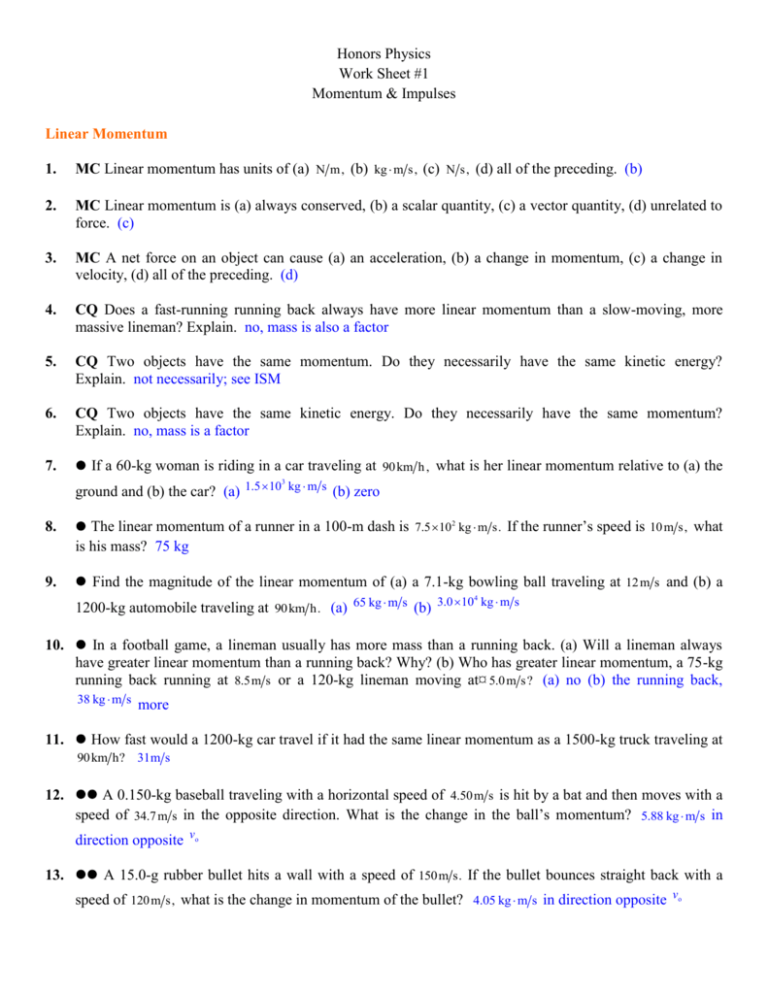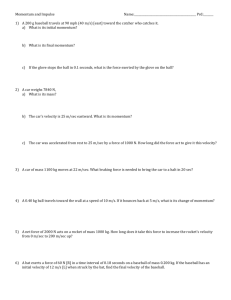Honors Physics Work Sheet #1 Momentum & Impulses Linear
advertisement

Honors Physics Work Sheet #1 Momentum & Impulses Linear Momentum 1. MC Linear momentum has units of (a) N m, (b) kg m s , (c) N s , (d) all of the preceding. (b) 2. MC Linear momentum is (a) always conserved, (b) a scalar quantity, (c) a vector quantity, (d) unrelated to force. (c) 3. MC A net force on an object can cause (a) an acceleration, (b) a change in momentum, (c) a change in velocity, (d) all of the preceding. (d) 4. CQ Does a fast-running running back always have more linear momentum than a slow-moving, more massive lineman? Explain. no, mass is also a factor 5. CQ Two objects have the same momentum. Do they necessarily have the same kinetic energy? Explain. not necessarily; see ISM 6. CQ Two objects have the same kinetic energy. Do they necessarily have the same momentum? Explain. no, mass is a factor 7. If a 60-kg woman is riding in a car traveling at 90 km h , what is her linear momentum relative to (a) the 3 ground and (b) the car? (a) 1.5 10 kg m s (b) zero 8. The linear momentum of a runner in a 100-m dash is 7.5 102 kg m s. If the runner’s speed is 10 m s, what is his mass? 75 kg 9. Find the magnitude of the linear momentum of (a) a 7.1-kg bowling ball traveling at 12 m s and (b) a 4 1200-kg automobile traveling at 90 km h. (a) 65 kg m s (b) 3.0 10 kg m s 10. In a football game, a lineman usually has more mass than a running back. (a) Will a lineman always have greater linear momentum than a running back? Why? (b) Who has greater linear momentum, a 75-kg running back running at 8.5m s or a 120-kg lineman moving at¤ 5.0 m s ? (a) no (b) the running back, 38 kg m s more 11. How fast would a 1200-kg car travel if it had the same linear momentum as a 1500-kg truck traveling at 90 km h? 31m s 12. A 0.150-kg baseball traveling with a horizontal speed of 4.50 m s is hit by a bat and then moves with a speed of 34.7 m s in the opposite direction. What is the change in the ball’s momentum? 5.88 kg m s in direction opposite vo 13. A 15.0-g rubber bullet hits a wall with a speed of 150 m s. If the bullet bounces straight back with a speed of 120 m s , what is the change in momentum of the bullet? 4.05 kg m s in direction opposite vo 15. Taking the density of air to be 1.29kg m3 , what is the magnitude of the linear momentum of a cubic meter of air moving with a wind speed of (a) 36 km h and (b) 74 mi h (the wind speed at which a tropical storm becomes a hurricane)? (a) 13 kg m s (b) 43 kg m s 16. Two runners of mass 70 kg and 60 kg, respectively, have a total linear momentum of 350 kg m s. The heavier runner is running at 2.0 m s. Determine the possible velocities of the lighter runner. 3.5m s in same direction or 8.2 m s in opposite direction Wilson, Bufa, Lou P 208 #1-16 Impulse 1. MC Impulse has units (a) kg m s , (b) N s, (c) the same as momentum, (d) all of the preceding. (d) 2. MC Impulse is equal to (a) F x, (b) the change in kinetic energy, (c) the change in momentum, (d) p t . (c) 3. CQ “Follow-through” is very important in many sports, such as in serving a tennis ball. Explain how follow-through can increase the speed of the tennis ball when it is served. increase contact time so to increase impulse 4. CQ A karate student tries not to follow through in order to break a board, as shown in Fig. 6.28. How can the abrupt stop of the hand (with no follow-through) generate so much force? 5. CQ Explain the principle behind (a) the use of Styrofoam as packing material to prevent objects from breaking, (b) the use of shoulder pads by football players to prevent injuries, and (c) the thicker glove used by a baseball catcher than by his teammates in the field. greater contact time—less average force 6. When tossed upward and hit horizontally by a batter, a 0.20-kg softball receives an impulse of 3.0 N s. With what horizontal speed does the ball move away from the bat? 15 m s 7. An automobile with a linear momentum of 3.0 104 kg m s is brought to a stop in 5.0 s. What is the magnitude of the average braking force? 6.0 103 N 8. A pool player imparts an impulse of 3.2 N s to a stationary 0.25-kg cue ball with a cue stick. What is the speed of the ball just after impact? 13m s Wilson, Bufa, Lou P 209 # 26-29, 31-34 Selected Answers #4 By stopping, the contact time is short. From the impulse momentum theorem (Favg t = p = mv mvo), a shorter contact time will result in a greater force if all other factors (m, vo, v) remain the same.








